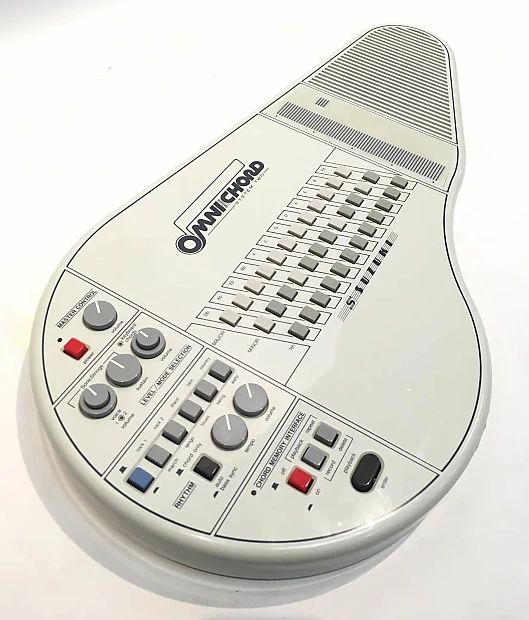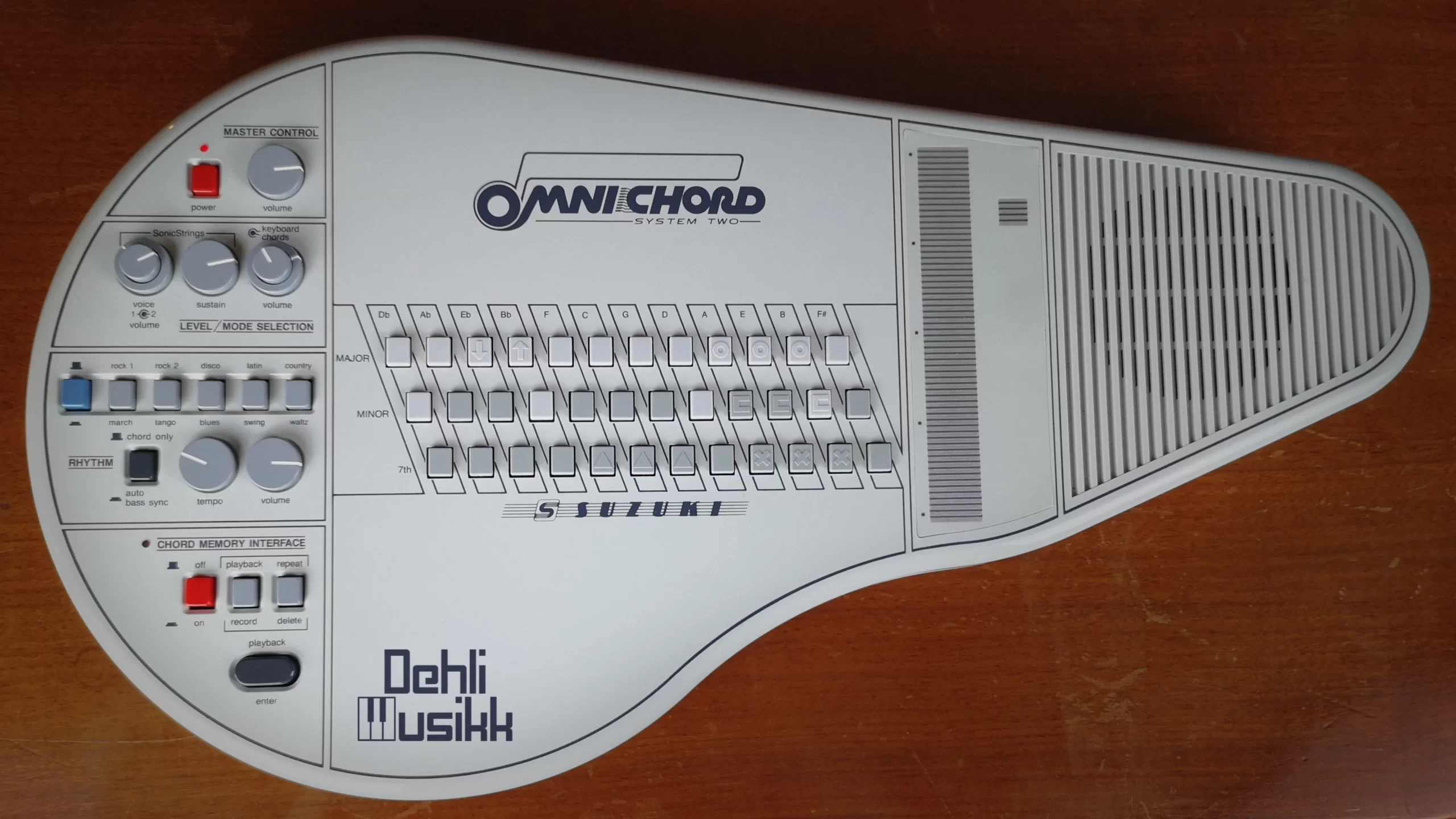Omnichord
Electronic Instruments
Asia
Between 1901 and present
Video
The Omnichord is a distinctive electronic musical instrument developed by the Japanese company Suzuki in the early 1980s. Designed as an easy-to-play instrument, it was initially marketed as a modern alternative to traditional autoharps, allowing musicians and hobbyists to create music effortlessly. The Omnichord features a built-in electronic sound system, a strumplate that simulates stringed instrument playability, and chord buttons that enable quick chord changes. Over the years, this instrument has gained popularity in various music genres, including pop, folk, electronic, and experimental music.
Unlike conventional musical instruments, the Omnichord does not rely on acoustic vibrations or mechanical parts to produce sound. Instead, it utilizes electronic synthesis, making it a hybrid between a keyboard and a stringed instrument. Its unique features and innovative playability have made it a favorite among musicians looking for a blend of traditional and modern musical elements.
History and Origin of the Omnichord
The Omnichord was first introduced in 1981 by Suzuki, a company known for manufacturing a variety of musical instruments and educational tools. Originating in Japan, the instrument was created to provide an easy and accessible way for people to create music, regardless of their musical background. The 1980s was a period of rapid technological advancement in the music industry, with synthesizers and electronic instruments gaining widespread popularity. The Omnichord was Suzuki’s answer to this growing trend, offering an intuitive and versatile instrument that could appeal to beginners and professional musicians alike.
Although it was originally designed as a simplified version of an autoharp, the Omnichord quickly gained a reputation for its distinct electronic tones and its ability to produce unique soundscapes. Throughout the 1980s and 1990s, Suzuki released various models, each with enhanced features and improved sound quality. The instrument became particularly popular in experimental and ambient music due to its ethereal and dreamy tones.
While the Omnichord was primarily developed in Japan, it gained international recognition and was embraced by musicians across North America and Europe. Its futuristic design and electronic capabilities made it a sought-after instrument among those looking for an alternative to traditional keyboards and synthesizers.
Types and Features of the Omnichord
The Omnichord has undergone several iterations since its inception, with each model introducing new features and enhancements. Despite these variations, all Omnichords share some fundamental characteristics that define their unique sound and playability.
Basic Features of the Omnichord
The Omnichord features a series of chord buttons that allow users to play major, minor, and seventh chords effortlessly. This feature eliminates the need for complex finger positioning, making the instrument highly accessible. One of the most distinctive elements of the Omnichord is its touch-sensitive strumplate. By sliding a finger across the plate, users can mimic the sound of strumming a guitar or autoharp. This feature allows for expressive and dynamic playing. Most models come with an internal speaker, enabling users to play without requiring external amplification. However, it also includes audio output options for professional use. Many Omnichord models come with preset rhythm patterns that provide drum beats and background accompaniment, making it easier for users to create full arrangements. Some models include additional sound effects, reverb, and modulation controls, allowing musicians to customize their sound.
Different Models of the Omnichord
OM-27: The first Omnichord model, introduced in 1981, featured 27 chord buttons and a basic strumplate. It was a simple yet revolutionary instrument that set the foundation for later models.
OM-36 and OM-84: These models introduced additional chord variations and improved sound quality, offering more flexibility to musicians. The OM-84, in particular, featured an extended range of chords.
System Two and System 100: These models incorporated advanced digital sound technology, allowing for greater versatility and more refined tones.
Q-Chord: The Q-Chord is the modern successor to the Omnichord, featuring digital sound banks, MIDI compatibility, and expanded sound options. It retains the fundamental features of the original Omnichord while incorporating new technological advancements.
Work Mechanics and Playing Technique
The Omnichord is designed to be user-friendly, making it an ideal instrument for beginners and professionals alike. Unlike traditional instruments that require years of practice to master, the Omnichord allows users to create complex musical arrangements with minimal effort.
How the Omnichord Works
At its core, the Omnichord operates as an electronic synthesizer that generates sound through digital oscillators. The instrument consists of two main interactive components: the chord buttons and the strumplate.
The player selects a chord by pressing the corresponding button. Each button is labeled with a specific chord name, such as C Major, D Minor, or G7. The instrument automatically generates the harmonic structure of the selected chord. Once a chord is selected, the player can glide their finger across the touch-sensitive strumplate to produce a melodic sound. The strumplate simulates the effect of plucking or strumming strings, offering a dynamic playing experience. Many Omnichords come with built-in drum beats and rhythm accompaniments. Players can activate these rhythms to provide a backing track, creating a full-band effect. Some models include pitch adjustment, reverb, and modulation effects, allowing users to manipulate the sound to suit their musical style.
Role of the Omnichord in Music
The Omnichord has carved out a niche for itself in various music genres, from folk and pop to electronic and experimental music. Its distinct sound and easy playability make it a versatile instrument that can complement different musical styles.
Use in Pop and Rock Music
Several musicians and bands have incorporated the Omnichord into their music, appreciating its unique timbre and nostalgic electronic sound. Artists such as Damon Albarn of Blur and Gorillaz, Björk, and David Bowie have experimented with the Omnichord, using it to add texture and atmosphere to their compositions.
Role in Folk and Indie Music
The Omnichord’s warm, dreamy tones have made it a favorite among folk and indie musicians. Its simplicity allows singer-songwriters to accompany themselves without requiring a full band. The instrument’s soft, harp-like sound blends well with acoustic arrangements, adding a magical quality to folk music.
Influence on Electronic and Ambient Music
The Omnichord’s electronic nature has also made it popular in ambient and experimental music. Artists exploring lo-fi, synth-driven soundscapes often use the Omnichord to create ethereal and meditative compositions. The instrument’s ability to produce sustained, layered tones makes it an excellent choice for atmospheric music.
Significance of the Omnichord
The Omnichord is more than just a musical instrument; it is a cultural artifact that represents the fusion of tradition and technology. Its significance lies in its accessibility, innovation, and lasting impact on the music world.
The Omnichord was designed to be an easy-to-play instrument, making music creation accessible to people with little or no prior musical training. It has been widely used in music therapy, education, and personal entertainment. As one of the first electronic chord-based instruments, the Omnichord played a role in bridging the gap between acoustic and digital music. Its unique features have inspired the development of other hybrid instruments. Despite being introduced decades ago, the Omnichord continues to enjoy a cult following. Musicians and collectors seek vintage models, and modern digital versions, such as the Q-Chord, keep its legacy alive. The Omnichord has been featured in numerous recordings and live performances across genres. Its distinctive sound has contributed to iconic musical moments and continues to be a source of inspiration for artists worldwide.
The Omnichord is a remarkable musical instrument that stands at the intersection of innovation and tradition. Its origins in 1980s Japan marked the beginning of a new era in electronic music, and its influence has endured over the decades. With its unique design, intuitive playability, and distinct sound, the Omnichord has found its way into diverse musical genres, from pop and rock to folk and electronic music.
FAQ
What is the origin of the Omnichord?
The Omnichord originated in Japan in the late 20th century, specifically introduced by Suzuki Musical Instrument Corporation in 1981. It was designed to be an accessible electronic instrument for both musicians and non-musicians alike.
How has the Omnichord been used in music?
The Omnichord has been used in various musical genres, adding a unique ethereal quality to compositions. It has been utilized by famous artists such as David Bowie and Rebecca Sugar in their work.
What makes the Omnichord easy to play?
The Omnichord is easy to play because it allows users to create harmonized sounds without needing to learn complex chord shapes. Users simply press chord buttons and strum the plate to produce sound.
 Links
Links
References
 Similar
Similar
Instruments
Other Instrument
Categories



















